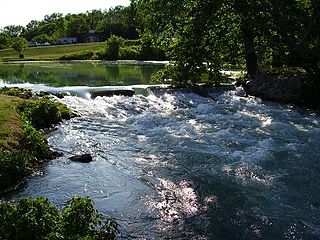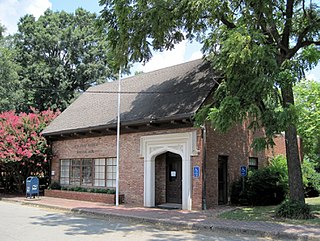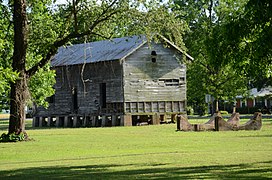
Bellows Falls is an incorporated village located in the town of Rockingham in Windham County, Vermont, United States. The population was 3,148 at the 2010 census. Bellows Falls is home to the Green Mountain Railroad, a heritage railroad; the annual Roots on the River Festival; and the No Film Film Festival.

Mammoth Spring State Park is a 62.5-acre (25.3 ha) Arkansas state park in Fulton County, Arkansas in the United States. The park is located surrounding National Natural Landmark of the same name to provide recreation and interpretation for visitors. The park offers fishing, boating and hiking in addition to an Arkansas Welcome Center and restored 1886 St. Louis–San Francisco Railway (Frisco) depot operating as a railroad museum. The site became a state park in 1957, but the park continued to add area until 1975.

Wakefield is a village in the town of South Kingstown, Rhode Island, United States, and the commercial center of South Kingstown. Together with the village of Peace Dale, it is treated by the U.S. Census as a component of the census-designated place identified as Wakefield-Peacedale, Rhode Island. West Kingston, another South Kingstown village, was the traditional county seat of Washington County. Since 1991, the Washington County Courthouse has been in Wakefield. The Sheriff's Office which handles corrections is also in Wakefield.

Concordville is an unincorporated community in Concord Township, Delaware County, Pennsylvania, United States. It is located 20 miles west-southwest of Philadelphia, at the junction of U.S. Routes 1 and 322. This intersection can be traced back to two of the earliest roads in Pennsylvania, Baltimore Pike which became U.S. 1, and Concord Pike, which connected Pennsylvania with Delaware.

Historic RittenhouseTown, sometimes referred to as Rittenhouse Historic District, encompasses the remains of an early industrial community which was the site of the first paper mill in British North America. The mill was built in 1690 by William Rittenhouse and his son Nicholas on the north bank of Paper Mill Run near Philadelphia, Pennsylvania. The district, off Lincoln Drive near Wissahickon Avenue in Fairmount Park, includes six of up to forty-five original buildings. RittenhouseTown was listed on the National Register of Historic Places and was designated a National Historic Landmark District on April 27, 1992.

Carolina is a village that straddles the border of the towns of Charlestown and Richmond on the Pawcatuck River in Washington County, Rhode Island. Rhode Island Route 112 passes through the village. Carolina is identified as a census-designated place, with a population of 970 at the 2010 census.

The Woonsocket Company Mill Complex is a historic district encompassing one of the largest mill complexes in Woonsocket, Rhode Island. The district includes all of the buildings historically associated with the Woonsocket Company, a major manufacturer of cotton textiles in the 19th century. The complex is located along the eastern bank of the Blackstone River between Court and Bernon Streets. It includes three handsome stone mills, built between 1827 and 1859, and a power plant that was built on the site of the former #3 mill between 1890 and 1920, as well as the remnants of the canal that originally carried water to the buildings for power.

The Talcottville Historic District is a historic district in the town of Vernon, Connecticut. Centered on Elm Hill Road and Main Street, it encompasses a 19th-century mill village, including archaeological remnants of very early cotton-spinning facilities, and old stone dam, and a major wood-frame mill constructed by the Talcott brothers. Also included in the village are a significant number of mill worker housing units, many dating to the middle decades of the 19th century, and an 1891 lenticular pony truss bridge, built by the Berlin Iron Bridge Company. The district was listed on the National Register of Historic Places in 1989.

King Philip Mills is an historic cotton mill complex located at 372 Kilburn Street in Fall River, Massachusetts. Developed between 1871 and 1892, it was historically one of the city's largest mills, and its building inventory is still largely complete. The complex was added to the National Register of Historic Places in 1983.

The Savage Mill Historic District is a national historic district located at Savage, Howard County, Maryland. The district comprises the industrial complex of Savage Mill and the village of workers' housing to the north of the complex.

Minterburn Mill is a former textile mill complex located at 215 East Main Street, in the Rockville village of Vernon, Connecticut. Developed beginning in 1834, it was the first place in Rockville to be developed industrially, and the surviving buildings provide a view of evolutionary changes in mill architecture. The mill was listed on the National Register of Historic Places in 1984. It was converted into an apartment complex in 2016 by the state.

The Johnson House and Mill is a group of historically significant structures at 3906 Johnson Mill Boulevard in Johnson, Arkansas, USA. The house is a two-story brick building, fashioned from locally manufactured bricks, and the mill is a large 2 1⁄2-story wood-frame structure with a gable roof and large waterwheel at one end. The mill was built c. 1865-67 and the house in 1882, by Jacob Q. Johnson, the town's namesake. The complex was listed on the National Register of Historic Places. The mill building, which operated well into the 20th century, has been converted into a hotel.

The Kemp Cotton Gin Historic District encompasses the only cotton gin extant in the Rohwer area of Desha County, Arkansas. The gin was built in 1950 by O. O. Kemp, a few years after the closure of the Rohwer War Relocation Center, where as many as 10,000 Japanese-Americans were interned during the Second World War. After the center's closure much of its land was returned to agricultural use, and Kemp built this gin near the Missouri Pacific Railroad line that ran through Rohwer. In addition to the gin, the complex Kemp built includes a pump house, scale house, and office. This entire complex was listed on the National Register of Historic Places in 2005.

The John H. Johnston Cotton Gin Historic District encompasses a historic cotton gin in the small community of Levesque, Arkansas. The main building of the gin was built in 1941, and was built out of reinforced concrete, instead of the more usual steel, owing to a metal shortage in World War II. It has some Moderne styling, with smooth surfaces and rounded corners. The gin also distinctively incorporates a seed storage facility at its rear. Its ancillary structures, which include a shed, privy, and cyclone structure, are wood-framed with metal siding and roofing.

Blackstone River Valley National Historical Park is a National Park Service unit in the states of Rhode Island and Massachusetts. The park was created for the purpose of preserving, protecting, and interpreting the industrial heritage of the Blackstone River Valley and the urban, rural, and agricultural landscape of that region. The Blackstone River Valley was the site of some of the earliest successful textile mills in the United States, and these mills contributed significantly to the earliest American Industrial Revolution. The subsequent construction of the Blackstone Canal, a few years after the successful completion of the Erie Canal, helped to sustain the region's industrial strength.

The Springdale Poultry Industry Historic District encompasses a small complex of commercial industrial buildings associated with the poultry industry in Springdale, Arkansas. Its three buildings included the original headquarters building of Tyson Foods, one of the world's largest producers of chicken meat. That building, at 319 East Emma Avenue, was built between 1914 and 1924 to house a produce store, and was extensively altered in 1947 to house the Tyson offices. Immediately adjacent at 317 East Emma is a chicken hatchery, built in 1924 by the Springdale Electric Hatchery Company and renamed the Jeff Brown Hatchery in 1949. The Tyson Feed Mill building stands behind these at 316 East Meadow. Jeff Brown was the first president of the Arkansas Poultry Improvement Association.

The Keo Commercial Historic District encompasses a cluster of commercial and industrial buildings that make up the economic center of the small city of Keo, Arkansas. The district includes a two-block section of Main Street, anchored at its southern end by the Cobb Cotton Gin complex, and on the north by Arkansas Highway 232, where it extends a short way in both directions. The community grew around the Cotten Belt Railroad line, which Main Street was laid out just west of. The cotton gin complex has its origins in 1906, as a means for local farmers to process their cotton and send it on to market via the railroad.

The Stipe Cotton Gin is a historic cotton gin at Florida and Cypress Streets in Beebe, Arkansas. It is a two-story steel-framed structure, clad in corrugated metal, that houses the steam compressor and other equipment for processing and baling cotton. The complex also includes a seed storage building, and a circular structure of uncertain function. Built about 1930, it is one of only five to survive in White County from that period, when cotton production was locally at its peak.

The Walker Homestead Historic District encompasses a collection of related agricultural and homesteading properties in rural White County, Arkansas. Located on Gum Spring Road about 1 mile (1.6 km) east of Arkansas Highway 267 southwest of Searcy, the district includes two farmstead houses, a barn, tenant housing, cotton gin, and other features. The oldest portion of the oldest house is a single pen log structure built about 1850 by William Walker, one of the area's early settlers, while the other house is a c. 1900 vernacular Greek Revival structure built by Billy Walker, Sr. The district encapsulates a typical evolutionary history of rural properties in the region, and was listed on the National Register of Historic Places in 1992.

The Willson Commercial Historic District encompasses the commercial and industrial heart of Wilson, Arkansas. Founded in 1886 as a company town by Robert Edward Lee Wilson, the city's growth was regulated and planned by the company until it was formally incorporated in 1950. This district encompasses the historic town square, commercial buildings, and the administrative and industrial buildings of the company's cotton gin and flour mill.

























